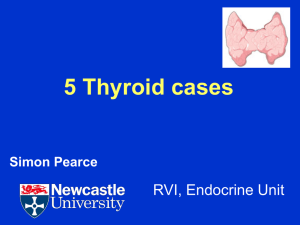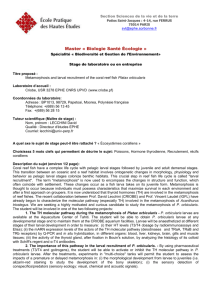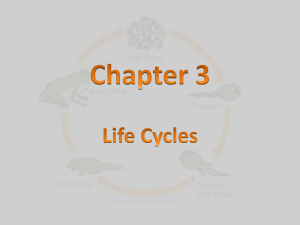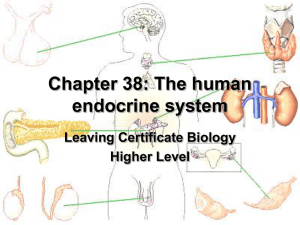Hodinetal1 - Stanford University
advertisement
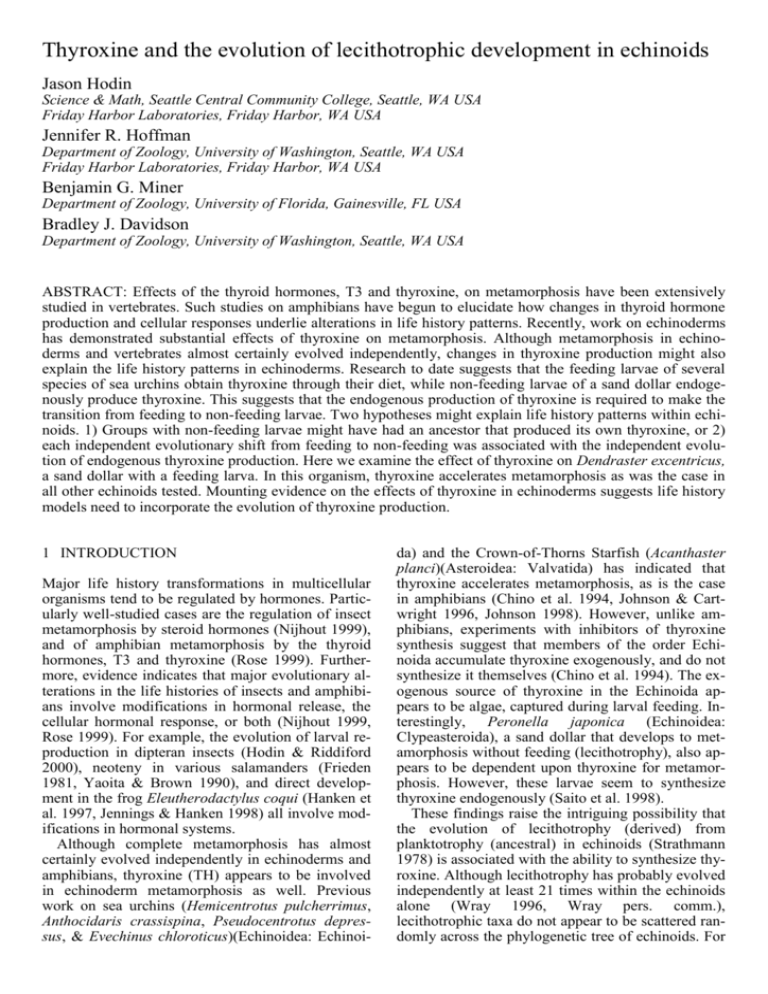
Thyroxine and the evolution of lecithotrophic development in echinoids Jason Hodin Science & Math, Seattle Central Community College, Seattle, WA USA Friday Harbor Laboratories, Friday Harbor, WA USA Jennifer R. Hoffman Department of Zoology, University of Washington, Seattle, WA USA Friday Harbor Laboratories, Friday Harbor, WA USA Benjamin G. Miner Department of Zoology, University of Florida, Gainesville, FL USA Bradley J. Davidson Department of Zoology, University of Washington, Seattle, WA USA ABSTRACT: Effects of the thyroid hormones, T3 and thyroxine, on metamorphosis have been extensively studied in vertebrates. Such studies on amphibians have begun to elucidate how changes in thyroid hormone production and cellular responses underlie alterations in life history patterns. Recently, work on echinoderms has demonstrated substantial effects of thyroxine on metamorphosis. Although metamorphosis in echinoderms and vertebrates almost certainly evolved independently, changes in thyroxine production might also explain the life history patterns in echinoderms. Research to date suggests that the feeding larvae of several species of sea urchins obtain thyroxine through their diet, while non-feeding larvae of a sand dollar endogenously produce thyroxine. This suggests that the endogenous production of thyroxine is required to make the transition from feeding to non-feeding larvae. Two hypotheses might explain life history patterns within echinoids. 1) Groups with non-feeding larvae might have had an ancestor that produced its own thyroxine, or 2) each independent evolutionary shift from feeding to non-feeding was associated with the independent evolution of endogenous thyroxine production. Here we examine the effect of thyroxine on Dendraster excentricus, a sand dollar with a feeding larva. In this organism, thyroxine accelerates metamorphosis as was the case in all other echinoids tested. Mounting evidence on the effects of thyroxine in echinoderms suggests life history models need to incorporate the evolution of thyroxine production. 1 INTRODUCTION Major life history transformations in multicellular organisms tend to be regulated by hormones. Particularly well-studied cases are the regulation of insect metamorphosis by steroid hormones (Nijhout 1999), and of amphibian metamorphosis by the thyroid hormones, T3 and thyroxine (Rose 1999). Furthermore, evidence indicates that major evolutionary alterations in the life histories of insects and amphibians involve modifications in hormonal release, the cellular hormonal response, or both (Nijhout 1999, Rose 1999). For example, the evolution of larval reproduction in dipteran insects (Hodin & Riddiford 2000), neoteny in various salamanders (Frieden 1981, Yaoita & Brown 1990), and direct development in the frog Eleutherodactylus coqui (Hanken et al. 1997, Jennings & Hanken 1998) all involve modifications in hormonal systems. Although complete metamorphosis has almost certainly evolved independently in echinoderms and amphibians, thyroxine (TH) appears to be involved in echinoderm metamorphosis as well. Previous work on sea urchins (Hemicentrotus pulcherrimus, Anthocidaris crassispina, Pseudocentrotus depressus, & Evechinus chloroticus)(Echinoidea: Echinoi- da) and the Crown-of-Thorns Starfish (Acanthaster planci)(Asteroidea: Valvatida) has indicated that thyroxine accelerates metamorphosis, as is the case in amphibians (Chino et al. 1994, Johnson & Cartwright 1996, Johnson 1998). However, unlike amphibians, experiments with inhibitors of thyroxine synthesis suggest that members of the order Echinoida accumulate thyroxine exogenously, and do not synthesize it themselves (Chino et al. 1994). The exogenous source of thyroxine in the Echinoida appears to be algae, captured during larval feeding. Interestingly, Peronella japonica (Echinoidea: Clypeasteroida), a sand dollar that develops to metamorphosis without feeding (lecithotrophy), also appears to be dependent upon thyroxine for metamorphosis. However, these larvae seem to synthesize thyroxine endogenously (Saito et al. 1998). These findings raise the intriguing possibility that the evolution of lecithotrophy (derived) from planktotrophy (ancestral) in echinoids (Strathmann 1978) is associated with the ability to synthesize thyroxine. Although lecithotrophy has probably evolved independently at least 21 times within the echinoids alone (Wray 1996, Wray pers. comm.), lecithotrophic taxa do not appear to be scattered randomly across the phylogenetic tree of echinoids. For Table 1. Experimental treatments. Rhodo and Iso control replicates (20 hours) were converted to the below treatments on day 9. 20 hours 9 days † † Treatment Reps *Food TH *Food TH Rhodo Control 3 Rhodo 5000 none same same Rhodo + early TH 3 Rhodo 5000 10-10 M same same Rhodo + late TH low 3 Rhodo 5000 none same 10-11 M Rhodo + late TH high 3 Rhodo 5000 none same 10-9 M Late Starved 3 Rhodo 5000 none none none Late Starved + TH 3 Rhodo 5000 none none 10-9 M Iso Control (1) 3 Iso 8000 none same same Iso Control (2) 3 Iso 8000 none same same Iso + early TH 3 Iso 8000 10-10 M same same 100 90 80 70 60 50 40 30 20 10 0 Rhodo control Rhodo + early TH Rhodo + late TH low Rhodo + late TH high Starved Starved + TH A 90 # of individuals recovered # of individuals recovered Iso + late TH 3 Iso 8000 none same 10-9 M *Rhodomonas lens is abbreviated as Rhodo and Isochrysis galbana is abbreviated Iso. Food concentrations are given as cells / ml. † The source of TH in all treatments was T4 (Sigma). B 80 70 Iso control (1) Iso control (2) Iso + early TH Iso + late TH 60 50 40 30 20 10 0 1 3 6 9 12 13 Days after fertizilation 1 3 6 9 12 Days after fertizilation 13 Figure 1. Number of individuals recovered for A) Rhodomonas treatments, and B) Isochrysis treatments. See table 1 for explanations of treatments. Note that y-axes are different. Error bars represent one standard error. example, the echinoid orders Diademitoida, Phymosomatoida and Holectypoida have no described lecithotrophs (Emlet 1995, McEdward & Miner in press), while there are several independent instances of lecithotrophy in the orders Clypeasteroida, Cidaroida and Spatangoida (Wray 1996, McEdward & Miner in press). Two hypotheses might explain the observed patterns of lecithotrophy. 1) The ability to endogenously synthesize thyroxine evolved early within groups with lecithotrophic development (namely, clypeasteroids, cidaroids and spatangoids). Thus, we would expect endogenous production of thyroxine in both planktotrophs and lecithotrophs within these groups. 2) An alternative possibility is that each independent evolutionary instance of lecithotrophy is associated with the independent evolution of endogenous thyroxine synthesis. In this case, related planktotrophs would not be expected to synthesize thyroxine. To address these two hypotheses, we propose a phylogenetic approach. This requires testing the effects of thyroxine in independently evolved lecithotrophs and their planktotrophic relatives. In addition, this approach will provide information on the morphogenetic role of thyroxine in echinoderm development. In insects, morphogenetic hormones (such as the insect ecdysteroid hormones) coordinate the timing of metamorphic processes. Thus, hetero- chronic alterations in echinoid development may result from alterations in thyroxine release, accumulation, or intracellular response. Here we report our first steps towards addressing the role of thyroxine in echinoid life history evolution. The effects of thyroxine on growth and metamorphosis were tested in Dendraster excentricus (Clypeasteroida), a sand dollar with planktotrophic larvae. We predict the effects of thyroxine would be similar to other species of echinoids tested. 2 MATERIALS AND METHODS Sand dollars (Dendraster excentricus) were collected at Crescent Beach, Orcas Island, Washington, USA at low tide in spring and summer 1999 and held in flow through sea tables with pre-conditioned sand. On August 31, 1999, one female and one male were spawned into Miliporetm-filtered seawater (MFSW, 0.45 m) using 0.55 M KCl. Eggs were washed 3 times in MFSW, and fertilized with fresh sperm diluted in MFSW. Fertilized eggs were washed after 5 minutes in MFSW. Twenty hours after fertilization, 80 normal late gastrulae / early prisms were placed in the initial treatments (Table 1). Nine days after fertilization, treatments were modified according to Table 1. Replicate cultures were set up in 300 ml of MFSW in glass beakers, and gently stirred using a shaker table at room temperature. Temperatures fluctuated daily from 21 degrees (before dawn) to 25 degrees (before dusk). The experiment ran for 13 days. Every 3 days larvae were transferred to MFSW with appropriate TH concentrations (T4 10-4 stock was diluted in distilled water). Larvae were then fed. At each water change and on the last day of the experiment (days 3, 6, 9, 12, and 13), larvae were scored for total number recovered, number dead, number abnormal (such as arm length asymmetries, dwarfism, and arm skeleton protrusions), and number metamorphosed (defined as the time when the juveniles stuck their tube feet to the bottom of the culture dish). Mortality and metamorphosis were analyzed for each sample date and each alga by an ANOVA test. We pooled the juvenile size data and used an ANOVA test to determine if juvenile sizes differed among treatments and between algae. Juvenile sizes were pooled because a nested ANOVA indicated that there were no differences among replicates (pvalue > 0.9). When ANOVA test results were significant (p-value < 0.05) a multiple comparison test (Fisher’s LSD) was used to determine which treatments differed. 3 RESULT 3.1 Mortality Larvae from control and thyroxine treatments experienced similar levels of mortality (Fig. 1). However percent mortality in the Iso + early TH treatment was significantly higher than other Iso treatments 6 days after fertilization (ANOVA; F-ratio = 4.928, pvalue = 0.032)(Fig. 1B). Mortality for all treatments was greatest 3 days after fertilization and then leveled off 6 days after fertilization. 3.2 Settlement of juveniles Very few larvae fed Rhodomonas without supplemented thyroxine (Rhodo control and late starved) had metamorphosed by the end of the experiment (day 13, Fig. 2A). In contrast, all augmented thyroxine treatments had increased numbers of metamorphs. Both Rhodo + early TH and Rhodo + late TH high treatments at day 12 (Fisher’s LSD; p-value = 0.010, p-value = 0.010, respectively) and Rhodo + late TH high at day 13 (Fisher’s LSD; p-value = 0.039) had significantly more metamorphs than the Rhodo control treatment. Additionally, Rhodo + late TH low and Rhodo + late TH high treatments indicate dose responsiveness (Fig. 2A). Results from larvae fed Isochrysis were similar to those described above for Rhodomonas treatments. The Iso + early TH treatment had a very high percentage of metamorphosis compared to all other Iso treatments 9, 12 and 13 days after fertilization (Fisher’s LSD; p-value < 0.001, p-value < 0.001, p-value < 0.001, respectively)(Fig. 2B). Late starved versus late starved + TH and control treatments (fed Rhodomonal lens) were compared to determine if larvae could endogenously synthesize TH. On day 13, the percentage of larvae that had metamorphosed from the late starved + TH treatment was significantly higher than in the late starved treatment without TH (Fisher’s LSD p-value = 0.013)(Fig. 2A). This difference indicates that Dendraster larvae do not endogenously synthesize sufficient TH for maximal metamorphosis. However, the Rhodo control and starved treatments did not differ. Although the starved larvae may have been utilizing previously-accumulated TH to complete metamorphosis, the fact that starved larvae can still metamorphose suggests that Dendraster larvae might harbor some ability to endogenously synthesize TH. Alternatively, TH may not be absolutely essential for (although it clearly promotes) settlement and the final events of metamorphosis in D. excentricus. 3.3 Juvenile size Early thyroxine treatments resulted in smaller juveniles than late TH treatments. However, this difference was only significant for the Iso treatments (Ttest28 = -5.889, p-value < 0.0001)(Fig. 3). In addi- 60% 40% Rhodo control Rhodo + early TH Rhodo + late TH low Rhodo + late TH high Starved Starved + TH A 20% 100% % Metamorphosis % Metamorphosis 80% B 80% 60% 40% 20% Iso control (1) Iso control (2) Iso + early TH Iso + late TH 0% 0% 9 12 13 Days after fertizilation 9 12 13 Days after fertizilation Figure 2. Percent of metamorphosis for A) Rhodomonas treatments, and B) Isochrysis treatments. See table 1 for explanations of treatments. Note that y-axes are different. Error bars represent one standard error. tion, there was a striking pattern with algal diet. Larvae from treatments fed Isochrysis metamorphosed at significantly smaller sizes than larvae from treatments fed Rhodomonas (ANOVA, F-ratio61 = 38.146, p-value < 0.001)(Fig. 3). 4 DISCUSSION TH-treated larvae of Dendraster excentricus metamorphosed earlier than untreated controls, and larvae in early TH treatments metamorphosed at a smaller size than larvae in late TH treatments (fed Isochrysis galbana). Late food withdrawal treatments (Rhodomonas lens) suggest that exogenous TH promotes maximal metamorphosis in D. excentricus. Larvae fed Rhodomonas lens metamorphosed at Juvenile Diameter (micrometers) 350 300 250 200 150 100 50 0 Rhodo + Rhodo + Iso + Iso + late early TH late TH early TH TH low Figure 3. Juvenile sizes showing no overall effect of thyroxine, but an effect of algal diet. Error bars represent one standard error among cultures. larger sizes than larvae fed Isochrysis galbana. These results support our prediction that thyroxine effects on Dendraster excentricus would be similar to other echinoids. Data to date indicate that thyroxine is an important hormone in the metamorphic processes of echinoids (Chino et al. 1994, Johnson 1998, Saito et al. 1998, our results), and may play a role in other echinoderm classes (Johnson & Cartwright 1996). Although echinoids and amphibians show similar responses to thyroid hormones, the independent evolution of metamorphosis in the two groups suggests thyroid hormone effects on metamorphosis are convergent. Although it seems clear that the metamorphic role of thyroid hormones evolved independently in amphibians and echinoderms, the association between thyroid syntheses and the evolution of lecithotrophy within echinoids is less clear. Saito et al. (1998) demonstrated that thyroxine is important for lecithotrophic development in Peronella japonica, and that larvae produced the needed hormone endogenously. We suggest a phylogenetic approach to determine when endogenous synthesis of thyroxine evolved in different echinoid lineages, and whether it correlates with life history patterns (lecithotrophy and planktotrophy) in these groups. Our results do not resolve the question of whether or not Dendraster larvae require exogenous thyroxine to complete metamorphosis. Resolving this question requires experiments examining thyroxine concentrations in larvae and algae, as well as the effects of thyroxine synthesis inhibitors on growth and metamorphosis. Recent experiments with the thyroxine synthesis inhibitor thiourea suggest that D. excentricus does synthesize thyroxine endogenously (Heyland and Hodin, in prep.). These results raise the intriguing possibility that, unlike strongylocentrotids, both lecthotrophic and planktotrophic clypeasteroids harbor the ability to synthesize thyroxine. This ability might have allowed the clypeasteroids to undergo the transition from planktotrophy to lecithotrophy more frequently. The need for thyroxine in the metamorphic processes of echinoids and other echinoderms suggests that thyroxine acquisition is an important factor shaping the ecology and evolution of the group. Furthermore, life history theory may need to incorporate the evolution of thyroxine synthesis into the traditional view of trade-offs between fecundity and development time (Christiansen & Fenchel 1979, McEdward 1997, Roughgarden 1989, Vance 1973a,b; exceptions Levitan 1993, 1996). Continued work on thyroxine within echinoderms and other groups of marine invertebrates will provide the groundwork for a synthesis of life history theory with proximate developmental mechanisms. ACKNOWLEDGEMENTS We thank the staff and visiting researchers at Friday Harbor Laboratories for space, help, equipment, and an eternally stimulating research environment. In particular we thank R. and M. Strathmann, B. Bybee, M. von Dassow, B. Pernet, S. Henderson, E. Iyengar, S. Menden-Deuer, M. Lamare, D. Padilla, B. Podolsky, M. Wilson, G. Wray, L. McEdward, and the Evolution of Devopmental Patterns 1994 and 1999 classes. Two reviewers, S. Long and M. Sewell, provided insightful comments that improved this manuscript. This work was partially supported by a Howard Hughes Medical Institute Predoctoral Fellowship to J. Hoffman and a NSF grant OCE9819593 to L. McEd ward. REFERENCES Chino, Y., M. Saito, K. Yamasu, T. Suyemitsu, & K. Ishihara 1994. Formation of the adult rudiment of sea urchins is influenced by thyroid hormones. Dev. Biol. 161:1-11. Christiansen, F.B., & T.M. Fenchel 1979. Evolution of marine invertebrate reproductive patterns. Theor. Popul. Biol. 16:267-282. Emlet, R.R. 1995. Developmental mode and species geographic range in regular sea urchins (Echinodermata: Echinoidea). Evolution. 49(3):476489. Frieden, E. 1981. The dual role of thyroid hormones in vertebrate development and calorigenesis. In L.I. Gilbert & E. Frieden (eds), Metamorphosis: A problem in developmental biology: 545563. New York: Plenum Press. Hanken, J., D.H. Jennings, & L. Olsson. 1997. Mechanistic basis of life-history evolution in anuran amphibians: direct development. Am. Zool. 37:160-171. Hodin, J., & L.M. Riddiford. 2000. Parallel alterations in the timing of ovarian Ecdysone Receptor and Ultraspiracle expression characterize the independent evolution of larval reproduction in two species of gall midges (Diptera: Cecidomyiidae). Dev. Genes Evol. 210:358372. Jennings, D.H., & J. Hanken. 1998. Mechanistic basis of life-history evolution in anuran amphibians: thyroid gland development in the directdeveloping frog, Eleutherodactylus coqui. Gen. Comp. Endocrinol. 11:225-232. Johnson, L.G. 1998. Stage-dependent thyroxine effects on sea urchin development. New Zeal. J. Mar. Fresh. Res. 32:531-536. Johnson, G.L., & C.M. Cartwright 1996. Thyroxineaccelerated larval development in the Crownof-Thorns Starfish, Acanthaster planci. Bio. Bull. 190:299-301. Levitan, D.R. 1993. The importance of sperm limitation to the evolution of egg size in marine invertebrates. Am. Nat. 141:517-536. Levitan, D.R. 1996. Predicting optimal and unique egg sizes in free-spawning marine invertebrates. Am. Nat. 148:174-188. McEdward, L.R. 1997. Reproductive strategies of marine benthic invertebrates revisited: facultative feeding by planktotrophic larvae. Am. Nat. 150(1):48-72. McEdward, L.R., & B.G. Miner. In press. Larval and life cycle patterns in echinoderms. Can. J. Zool. Nijhout, H.F. 1999. Hormonal control in larval development and evolution – Insects. In B.K. Hall & M.H. Wake (eds), The origin and evolution of larval forms: 218-254. Academic Press, San Diego, CA. Rose, C.S. 1999. Hormonal control in larval development and evolution – Amphibians. In B.K. Hall & M.H. Wake (eds), The origin and evolution of larval forms: 167-217. Academic Press, San Diego, CA. Roughgarden, J. 1989. The evolution of marine life cycles. In M.W. Feldman (ed), Mathematical evolutionary theory: 270-330. Princeton University Press, Princeton, NJ. Saito, M., M. Seki, S. Amemiya, K. Yamasu, T. Suyemitsu, & K. Ishihara 1998. Induction of metamorphosis in the sand dollar Peronella japonica by thyroxine hormones. Develop. Growth Differ. 40:307-312. Strathmann, R.R. 1978. The evolution and loss of feeding larval stages of marine invertebrates. Evolution. 32:894-906. Vance, R.R. 1973a. On reproductive strategies in marine benthic invertebrates. Am. Nat. 107:339-352. Vance, R.R. 1973b. More on reproductive strategies in marine benthic invertebrates. Am. Nat. 107:353-361. Wray, G.A. 1996. Parallel evolution of nonfeeding larvae in echinoids. Syst. Biol. 45:308-322. Yaoita, Y., & D.D. Brown. 1990. A correlation of thyroid hormone receptor gene expression with amphibian metamorphosis. Genes Dev. 4:1917-1924.

